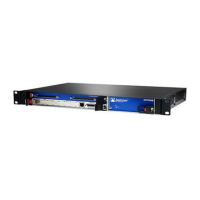the handset), the switch is closed between the T and R leads to complete a loop between
the battery and ground in the FXS device. The FXS device detects the current, which
flows from the battery (–48 V) through the R leads and back through the T leads to
ground and stops the ring voltage.
When a call is initiated by the CPE (or FXO) device, the device goes off-hook, closing the
connection between the T and R leads. The FXS device senses the current flow in the
loop. Either the attached FXS device, or an upstream FXS device, provides dial tone to
the FXO device after it is ready to accept the digits for the call destination. Providing dial
tone is a form of start-dial supervision.
On the FXO device, when the device is on-hook, there is an open lead between the T and
R leads. When the device is off-hook, the T and R leads are shorted with a typical load
of ~300 Ohms. With loop-start, the T and R leads on the FXO interface can be switched
without adversely affecting the signaling.
Glare occurs when a call is established by the FXS device and the FXO tries to make a
call before the ring has been detected. Because it takes time for the FXO device (or person
about to place a call) to detect ringing, it is possible for the FXS and FXO devices to both
seize the line without knowledge that the other end has done so. Ground-start circuits
were established the minimize the possibility of glare. See “Analog FXS/FXO Ground-Start
Signaling” on page 21.
Answer Supervision
Answer supervision is a signal used by the phone companies to determine when to start
billing the originator of the call. Without answer supervision, you could get billed for the
time the phone was ringing, even if the call was never picked up. When the FXS device
has detected that the FXO device has gone off-hook, it reverses the polarity between
the T and R leads for the duration of the call.
Disconnect Supervision
Disconnect supervision is a signal sent by the FXS device to the FXO device to indicate
that the call has ended. The disconnect supervision signal can be either a battery reversal,
battery denial (more than 350 ms), or a tone.
Note that loop-start circuits are not sensitive to tip/ring reversal. For example, the tip on
the FXO device may be connected to either the tip or ring on the FXS.
Analog FXS/FXO Ground-Start Signaling
Ground-start signaling is used to minimize the potential for glare. Unlike loop-start circuits,
ground-start circuits operate correctly only when the FXO tip is connected to the FXS tip
and the FXO ring is connected to the FXS ring. Also, unlike loop-start circuits, the FXS
and FXO grounds must be at the same potential.
When on-hook, the FXO ring is not connected to either the tip or ground. Likewise, when
idle, the FXS tip is not connected to ground. When a call is initiated from the CO (FXS
side), the FXS grounds its tip and applies an AC ring voltage to the R lead. The FXO device
senses the grounded tip and AC ring voltage, and then goes off-hook by closing the loop
(connecting R to T). The FXO has 100 ms to respond to the grounded tip/ring voltage.
21Copyright © 2017, Juniper Networks, Inc.
Chapter 2: CTP2000 Series Interface Modules

